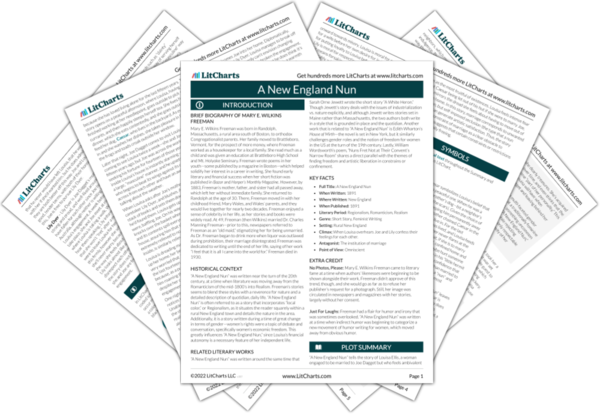Brief Biography of Mary E. Wilkins Freeman
Mary E. Wilkins Freeman was born in Randolph, Massachusetts, a rural area south of Boston, to orthodox Congregationalist parents. Her family moved to Brattleboro, Vermont, for the prospect of more money, where Freeman worked as a housekeeper for a local family. She read much as a child and was given an education at Brattleboro High School and Mt. Holyoke Seminary. Freeman wrote poems in her youth—some published by a magazine in Boston—which helped solidify her interest in a career in writing. She found early literary and financial success when her short fiction was published in Bazar and Harper’s Monthly Magazine. However, by 1883, Freeman’s mother, father, and sister had all passed away, which left her without immediate family. She returned to Randolph at the age of 30. There, Freeman moved in with her childhood friend, Mary Wales, and Wales’ parents, and they would live together for nearly two decades. Freeman enjoyed a sense of celebrity in her life, as her stories and books were widely read. At 49, Freeman (then Wilkins) married Dr. Charles Manning Freeman—prior to this, newspapers referred to Freeman as an “old maid,” stigmatizing her for being unmarried. As Dr. Freeman began to drink more when liquor was outlawed during prohibition, their marriage disintegrated. Freeman was dedicated to writing until the end of her life, saying of her work “I feel that it is all I came into the world for.” Freeman died in 1930.
Historical Context of A New England Nun
“A New England Nun” was written near the turn of the 20th century, at a time when literature was moving away from the Romanticism of the mid-1800’s into Realism. Freeman’s stories seems to blend these styles with a reverence for nature and a detailed description of quotidian, daily life. “A New England Nun” is often referred to as a story that incorporates “local color,” or Regionalism, as it situates the reader squarely within a rural New England town and details the nature in the area. Additionally, it is a story written during a time of great change in terms of gender—women’s rights were a topic of debate and conversation, specifically women’s economic freedom. This greatly influences “A New England Nun,” since Louisa’s financial autonomy is a necessary feature of her independent life.
Other Books Related to A New England Nun
“A New England Nun” was written around the same time that Sarah Orne Jewett wrote the short story “A White Heron.” Though Jewett’s story deals with the issues of industrialization vs. nature explicitly, and although Jewett writes stories set in Maine rather than Massachusetts, the two authors both write in a style that is grounded in place and the quotidian. Another work that is related to “A New England Nun” is Edith Wharton’s House of Mirth—the novel is set in New York, but it similarly challenges gender roles and the notion of freedom for women in the US at the turn of the 19th century. Lastly, William Wordsworth’s poem, “Nuns Fret Not at Their Convent’s Narrow Room” shares a direct parallel with the themes of finding freedom and artistic liberation in constrains or confinement.
Key Facts about A New England Nun
-
Full Title: A New England Nun
-
When Written: 1891
-
Where Written: New England
-
When Published: 1891
-
Literary Period: Regionalism, Romanticism, Realism
-
Genre: Short Story, Feminist Writing
-
Setting: Rural New England
-
Climax: When Louisa overhears Joe and Lily confess their feelings for each other.
-
Antagonist: The institution of marriage
-
Point of View: Omniscient
Extra Credit for A New England Nun








